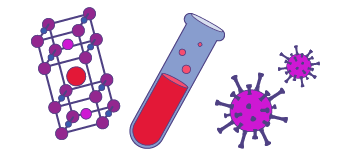Dielectric capacitance measures capacitance and dissipation of a bulk or thin film sample.
The measurement (tan δ) is performed using capacitance bridges, which automatically or manually balances the capacitance and dissipation of the sample with known standards. When a sample is prepared to a parallel capacitor geometry, the capacitance and the dissipation can be converted to real and imaginary part of dielectric constant (ε′ and ε″ respectively) using relations of C=ε0 ε′ Area ⁄ (thickness) and tan δ= ε″ ⁄ ε′ , where ε0 is permittivity of air.
Resistive Magnets
Superconducting Magnets
Hybrid Magnet

Explore our magnet schedule to see what exciting research is happening on our stellar fleet of instruments right now.
Silverstein, et al, Incommensurate crystal supercell and polarization flop observed in the magnetoelectric ilmenite MnTiO3, Phys. Rev. B, 93 (2016) Read online.
Zhao, et al, Spin-orbital liquid and quantum critical point in Y1−xLaxTiO3, Phys. Rev. B, 161106(R) (2015) Read online.
Cao, et al, High pressure floating zone growth and structural properties of ferrimagnetic quantum paraelectric BaFe12O19, Applied Physics Letters Materials, 3 (2015) Read online.
Lee, et al, Series of phase transitions and multiferroicity in the quasi-two-dimensional spin-1/2 triangular lattice antiferromagnet Ba3CoNb2O9, Physical Review B, 89 (2014) Read online.
Lee, et al, Magnetic phase diagram and multiferroicity of Ba3MnNb2O9: A spin-(5/2) triangular lattice antiferromagnet with weak easy-axis anisotropy, Phys. Rev. B, 90 (2014) Read online.
Besara, et al, Spin dynamics and magnetoelectric properties of the coupled-spin tetrahedral compound Cu2Te2O5Cl2, Phys. Rev. B, 90 (2014) Read online.
Chi, et al, Magnetoelectric coupling tuned by competing anisotropies in Mn1-xNixTiO3, Phys. Rev. B, 90 (2014) Read online.
Wang, Z., et al, Dimethylammonium copper formate [(CH3)2NH2]Cu(HCOO)3: A metal-organic framework with quasi-one-dimensional antiferromagnetism and magnetostriction, Physical Review B, 87 (2013) Read online.
Kismarahardja, A., et al, Dielectric properties of single crystal spinels in the series FeV2O4, MnV2O4, and CoV2O4 in high magnetic fields, Physical Review B (2013) Read online.
Silverstein, H. J., et al, Pb3TeCo3V2O14: A Potential Multiferroic Co Bearing Member of the Dugganite Series, Chem. Mater., 24 (2012) Read online.
Samantaray, R., et al, Elucidating the Mechanism of Multiferroicity in (NH4)3Cr (O2)4 and its Tailoring by Alkali Metal Substitution, J. Am. Chem. Soc., (2012) Read online.
Iyama, A., et al, High-magnetic field effect on interplay between Sm 4f and Mn 3d moments in SmMnO3, Journal of the Physical Society of Japan, 81 (2012) Read online.
Hwang, J., et al, Magnetic transitions and magnetodielectric effect in antiferromagnet SrNdFeO4, Physical Review B, 85 (2012) Read online.
Hwang, J., et al, Magnetoelectric effect in NdCrTiO5, Phys. Rev. B, 85 (2012) Read online.
Hwang, J., et al, Successive Magnetic Phase Transitions and Multiferroicity in the Spin-One Triangular-Lattice Antiferromagnet Ba3NiNb2O9, Physical Review Letters, 109 (2012) Read online.
Samantaray, R., et al, M3-x(NH4)xCrO8 (M = Na, K, Rb, Cs): A New Family of Cr5+-Based Magnetic Ferroelectrics, J. Am. Chem. Soc. (Comm.) 133 (2011) Read online.
Park, J., et al, Magnetoelectric Feedback among Magnetic Order, Polarization, and Lattice in Multiferroic BiFeO3, Journal of the Physical Society of Japan, 80 (2011) Read online.
Last modified on 13 December 2023